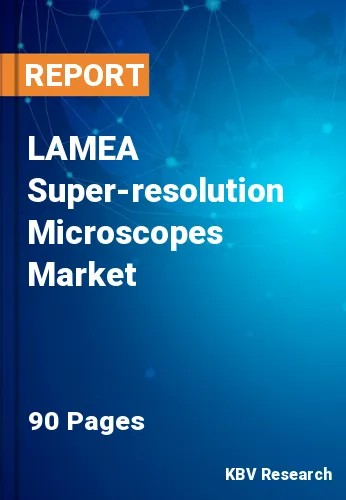The Latin America, Middle East and Africa Super-resolution Microscopes Market would witness market growth of 13.0% CAGR during the forecast period (2022-2028).
the market is anticipated to be driven by increasing applications across the life science industry, technical developments, and a growing focus on nanotechnology. Because they give higher X-Y resolution beyond 200 - 250 nm, super-resolution microscopes exceed the limitations of confocal and fluorescent microscopy. By providing resolutions of 10-20 nm, super-resolution microscopy is intended to provide new insights into ongoing research in medical science and nanotechnology. Researchers employ these sophisticated microscopes in medical procedures and diagnostics. Micro-endoscopy, for example, is utilized in combination with multiphoton and other sophisticated imaging technologies for the long-term use of these technologies in novel medical treatments.
The electronics industry in South Africa is very diversified and includes everything from consumer electronics to electrical machinery, home appliances, and telecommunications equipment. The nation generates electrotechnical equipment worth more than R90 billion annually, according to Statistics South Africa. Both the industrial electronics sector and the consumer electronics sector in South Africa are of the highest caliber. A total of 4% of South Africa's manufacturing output is accounted for by the production of electronics.
The output of manufacturing was 2.3% higher in 2018 owing to the electrical machinery subsector. About 1.1% of manufacturing production was made up of radio, television, and communication equipment and equipment. 0.6% of manufacturing production came from household appliances. Due to this, the semiconductor industry is rapidly growing in this region and this factor is estimated to have a direct impact on the growth of the super-resolution microscope market.
In addition, due to the prevalence of a significant number of diseases and disorders in the regional countries, like South Africa and the Middle East, the life science sector is also witnessing a surge in the demand for new breakthroughs. Therefore, with the rapid growth of the semiconductor industry and the life science sector of the region, the growth of the regional super-resolution market is also estimated to rise in the coming years.
The Brazil market dominated the LAMEA Super-resolution Microscopes Market by Country in 2021, and would continue to be a dominant market till 2028; thereby, achieving a market value of $100.8 Million by 2028. The Argentina market is estimated to grow at a CAGR of 13.6% during (2022 - 2028). Additionally, The UAE market would witness a CAGR of 12.7% during (2022 - 2028).
Based on Technology, the market is segmented into Stimulated Emission Depletion (STED) Microscopy, Structured-Illumination Microscopy (SIM), Stochastic Optical Reconstruction Microscopy (STORM), Fluorescence Photoactivated Localization Microscopy (FPALM), and Photoactivated Localization Microscopy (PALM). Based on Application, the market is segmented into Life Science, Material Science, Semi-conductor, Nanotechnology, and Others. Based on countries, the market is segmented into Brazil, Argentina, UAE, Saudi Arabia, South Africa, Nigeria, and Rest of LAMEA.
Free Valuable Insights: The Global Super-resolution Microscopes Market is Predict to reach $5.7 Billion by 2028, at a CAGR of 9.9%
The market research report covers the analysis of key stake holders of the market. Key companies profiled in the report include General Electric (GE) Co. (GE Healthcare), Carl Zeiss AG, Nikon Corporation, Olympus Corporation, Leica Microsystems GmbH (Danaher Corporation), Bruker Corporation, and Hitachi High Technologies Corporation (Hitachi, Ltd.)
By Technology
By Application
By Country
Our team of dedicated experts can provide you with attractive expansion opportunities for your business.

